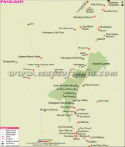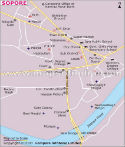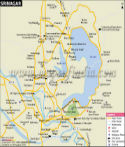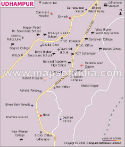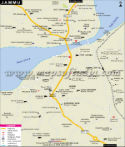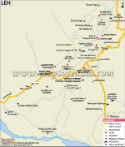One of the most beautiful, historic regions in South Asia, Jammu and Kashmir is often called the "Crown of India." Lying in the lap of the Himalayas, the region is famous for its beautiful scenery, cultural heritage, and historical importance. Travellers, historians, and political analysts alike have a special space in their hearts for Jammu and Kashmir. This article provides insights into the geography, history, culture, tourism, economy, and socio-political context of Jammu and Kashmir.
The first legislative assembly elections in Jammu and Kashmir since its special status was revoked in 2019 were held in October 2024. In the 50-member Jammu and Kashmir Assembly, 48 seats were won by the Jammu & Kashmir National Conference (JKNC) in alliance with the Indian National Congress (INC), just in time to enable the formation of a majority. After that, on October 16, 2024, Omar Abdullah took his oath as Chief Minister of JKNC.
For those in the region, this election was major political news; a locally elected government returned to the table after being ruled directly from the central government.
Geographical Diversity
Jammu and Kashmir (now a Union Territory of India) is a relatively geographically diverse place comprised of three distinctive regions: Jammu, the Kashmir Valley, and Ladakh. Ladakh has been carved out and made a separate Union Territory, but with its unique geography and cultural richness, Jammu and Kashmir remains a huge attraction.
The region is also home to beautiful mountain ranges, such as the Pir Panjal and the Greater Himalayas. The verdant meadows, pine, and snow-laden mountains of the Kashmir Valley and rivers like Jhelum are the things the Valley is famous for. Known as the "City of Temples," Jammu features hilly terrain with many pilgrimage spots. Jammu has a subtropical climate, while the climate is more temperate and cold in Kashmir, which makes Jammu and Kashmir a year-round attractive tourist destination.
Historical Background
Jammu and Kashmir areas have an ancient and chequered history spread over thousands of years. Ancient Hindu scriptures like the Mahabharata and Rajatarangini, written by Kalhana, which gives a detailed history of Kashmiri rulers, mention the region.
The area had been governed by dynasties, from Mauryas to Kushans to the Mughals. In the 16th century, Kashmir was incorporated into the Mughal Empire under Emperor Akbar, and successive emperors beautified the valley with gardens, mosques, and palaces.
The British took control over J&K during the 19th century. In 1846, after the Treaty of Amritsar, the British sold Kashmir to Maharaja Gulab Singh, establishing the princely state of Jammu and Kashmir under Dogra rule. It had remained with the Dogra dynasty until 1947, when India was freed, which led to a huge political development.
Accession to India and Political Developments
The 1947 partition of British India resulted in the birth of India and Pakistan. Princely states were allowed to decide whether to join either country or remain independent then. Having previously wanted to remain independent, Maharaja Hari Singh of Jammu and Kashmir signed the Instrument of Accession with India after tribal invasions backed by Pakistan in October 1947.
After its annexation, several wars were fought between India and Pakistan, and the region was split into two parts, with India controlling Jammu and Kashmir and Pakistan controlling what it calls "Azad Jammu and Kashmir" and Gilgit-Baltistan. We may note that this territorial conflict has already caused several decades of both military and diplomatic issues between the countries of India and Pakistan.
On 5th August 2019, the Government of India revoked Article 370, which gave special status to Jammu and Kashmir. It was split into two Union Territories- Jammu & Kashmir and Ladakh. The paradigm shift was both lauded and criticised, resulting in drastic socio-political upheavals across the territory.
Cultural Heritage and Traditions
Its rich and diverse culture is underlined by its Hindu, Buddhist, and Islamic heritage and can be felt all across Jammu and Kashmir. The region boasts a rich history in classical music, folk dance forms, and festivities.
- KashmiriCulture: Kashmiri culture has a lot of influence from Persian and Central Asian traditions. People of Kashmir are very hospitable and artistic in nature; they are good at handicrafts, especially Pashmina shawls, carpets, paper mache, and many others. Kashmiri is widely spoken in the valley and belongs to the Dardic group of Indo-Aryan languages.
- Jammu Culture: Jammu is a land of temples and is deeply influenced by traditions of Dogra. They speak in the Dogri language, and their folk music and dance forms are famous, such as Kud and Hiran.
- Festivals: Festivals such as Eid, Diwali, Lohri, and Baisakhi are celebrated in the region. Every year, millions take the yearly Amarnath Yatra and the Vaishno Devi- another pilgrimage.
Tourism: The Backbone of the Economy
Tourism is an important part of the Jammu Kashmir economy. Some examples of famous tourist attractions are:
- Srinagar: Famous for its signature Dal Lake, houseboats, and Mughal gardens.
- Gulmarg:Land of winter sports, skiing, and the world's highest golf course.
- Pahalgam: Pahalgam, the starting point for the Amarnath Yatra, is a serene hill station in Anantnag District.
- Jammu: This is where you’ll find the famous Vaishno Devi Temple, one of India’s biggest pilgrimages for Hindus.
- Sonmarg: A stunning valley and glacier that serves as an entry point to Ladakh.
In addition, the region is known for adventure sports, including trekking, river rafting, and paragliding, making it a popular spot for nature and adventure lovers.
Economy and Agriculture
Tourism aside, agriculture is an important pillar of the economy of Jammu and Kashmir. The region is famous for:
- Horticulture:P Kashmir earned the name the “Fruit Bowl of India” with fine production of apples, cherries, walnuts, and saffron.
- Handicrafts: PPashmina shawls, Kashmiri carpets, and woodwork are famous worldwide.
- Sericulture:P High quality silk production helps the local economy.
Over the last few years, many industries, IT hubs, and infrastructure projects have been promoted to accelerate economic development.
Challenges and Future Prospects
Jammu and Kashmir come with their beauty and resources despite facing challenges of political instability, issues of security, and economic hardships. Yet the government's focus on boosting international tourism and investment makes for a more optimistic outlook.
Transformed with the establishment of the newest learning centres, better road networks, and projects like enhancing villages through "Back to Village" programs. Youth empowerment, skill development, and digital connectivity have been the foundation stones for the future of Jammu and Kashmir.
Conclusion
Jammu and Kashmir are integral parts of the Indian cultural, historical, and geographical landscape. Well, it has some potential in other sectors like tourism, agriculture, and even industries, despite these challenges. With peace and stability restored, Jammu and Kashmir will continue to mesmerise tourists and contribute to a prosperous India. The spectacular beauty and glorious heritage of the place shall be forever known as "Jewel of India”.
With the region gradually progressing, it will be essential to encourage peace and sustainable growth for its continued prosperity. Investments in education, technology, and infrastructure can open new avenues. Through collaborative actions from the government, local communities, and private sectors, the region can become a beacon of peace, resilience, and economic success.
Last Updated on: April 23, 2025

